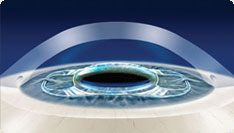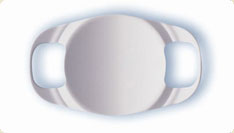Technology Links
Latest Technology
IntraLasik Technology IntraLase iFS
Allegretto Wavelight Eye-Q
VISX STAR S4
Alcon LADARVision 4000
Wavefront Mapping
ReZoom Multifocal IOL
AcrySof ReSTOR
Crystalens
Verisyse
|
THE VERISYSE PHAKIC IOL

The Verisyse Phakic Intraocular Lens (IOL) implant is recommended for patients who do not qualify for LASIK due to severe nearsightedness, farsightedness, or cases where the cornea is too thin for LASIK. For patients who undergo the Verisyse Phakic Intraocular Lens replacement implant procedure, the natural lens is left in place to retain the lens’ natural ability to read up close and adjust for objects farther away. In the past, before the Verisyse Phakic Intraocular Lens, many patients lost their ability to read up close and adjust for objects farther away without wearing corrective eyewear after lens replacement implant surgery.
 The Verisyse lens, recently approved by the FDA, has already been implanted in over 150,000 eyes in Europe, with a 60% implantation rate compared to all other phakic IOLs, over the past 18 years. It is composed of the same plastic material that has been used in lens implants for more than 30 years. The lens is easily inserted and if necessary, can be easily removed, making the entire procedure reversible. This outpatient procedure requires mild sedation and is performed in approximately 10-15 minutes. The Verisyse lens, recently approved by the FDA, has already been implanted in over 150,000 eyes in Europe, with a 60% implantation rate compared to all other phakic IOLs, over the past 18 years. It is composed of the same plastic material that has been used in lens implants for more than 30 years. The lens is easily inserted and if necessary, can be easily removed, making the entire procedure reversible. This outpatient procedure requires mild sedation and is performed in approximately 10-15 minutes.
FDA CLINICAL TRIALS
In a recent FDA clinical trial assessing 155 patients with nearsightedness ranging from -5.5 to -22.5 diopters, patient satisfaction ratings with Verisyse(tm) were as follows:
- 84% rated quality of vision “favorable”
- 91% rated satisfaction with surgery “favorable”
- 92% would recommend the procedure
In order to properly calculate the necessary power required of the Verisyse lens, Dr. Boothe will perform a refraction (measure of myopia), keratometry (measure of the power of the cornea) and biometry (measuring various eye dimensions).
The Verisyse procedure corrects myopia (nearsightedness) and the results have shown a quality of vision that is better than the results of a traditional LASIK procedure pushing the limits of what it was designed for. The Verisyse corrects from -5.00 up to -20.00 diopters of myopia or nearsightedness. This overlaps with the range that LASIK can correct, up to -12.00 D. The Verisyse is available in two different optic diameters for varying size pupils. In the future, some higher myopia LASIK candidates may actually receive Verisyse lens implants for the best visual correction.
Results show that the Verisyse lens can correct the majority of high degrees of myopia in patients. 85-90% of patients are 20/40 or better after the lens implant. Approximately 40% of patients may still need a LASIK enhancement to correct astigmatism or residual myopia. The Verisyse Lens has shown a lower risk of inducing a cataract either at the time of the procedure or long term when compared to other refractive IOLs.
As with any surgical procedure, there are risks including temporary or permanent vision loss. Your doctor will explain these risks to you and ensure that you understand them completely.
HOW VERISYSE WORKS
The procedure involves placing the Verisyse Refractive IOL behind your cornea and on top of your iris. This gives your eye another focusing lens that provides high-quality, high-definition vision like a normal eye. Although the Verisyse Phakic IOL is intended to be permanent, the procedure is reversible if desired. Leaving your natural crystalline lens in place is important because of its important role in helping your eye adjust between seeing objects that are near and far.
ABOUT THE VERISYSE PROCEDURE
Implanting the Verisyse IOL is an outpatient procedure that takes around 15 to 30 minutes. Usually, one eye is treated at a time.
- Drops will be placed in your eyes in order to reduce the pupil size.
- For better access to your eye, your doctor will use an instrument to comfortably hold your eyelids open during the procedure.
- A local anesthetic is given to sedate the eye.
- A small incision is made in the cornea for the Verisyse IOL to be placed in the space between the iris and the cornea.
- The Verisyse Refractive IOL is centered in front of the pupil (the black part in the center of your eye), and is gently attached to the iris (the colored part of your eye) to hold the lens in place.
- The small incision is closed with microscopic stitches that dissolve on their own.
- A temporary shield will be placed over your eye to protect it during the time just after the procedure.
Verisyse Web Marketing Powered by Ceatus Media Group LLC |
WaveFront Mapping
WaveFront Mapping technology is a tremendous breakthrough in laser vision correction and has the ability to produce better visual results than traditional LASIK laser vision correction.
|


 The Verisyse lens, recently approved by the FDA, has already been implanted in over 150,000 eyes in Europe, with a 60% implantation rate compared to all other phakic IOLs, over the past 18 years. It is composed of the same plastic material that has been used in lens implants for more than 30 years. The lens is easily inserted and if necessary, can be easily removed, making the entire procedure reversible. This outpatient procedure requires mild sedation and is performed in approximately 10-15 minutes.
The Verisyse lens, recently approved by the FDA, has already been implanted in over 150,000 eyes in Europe, with a 60% implantation rate compared to all other phakic IOLs, over the past 18 years. It is composed of the same plastic material that has been used in lens implants for more than 30 years. The lens is easily inserted and if necessary, can be easily removed, making the entire procedure reversible. This outpatient procedure requires mild sedation and is performed in approximately 10-15 minutes.